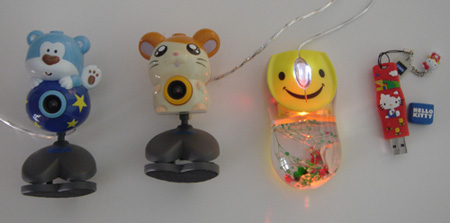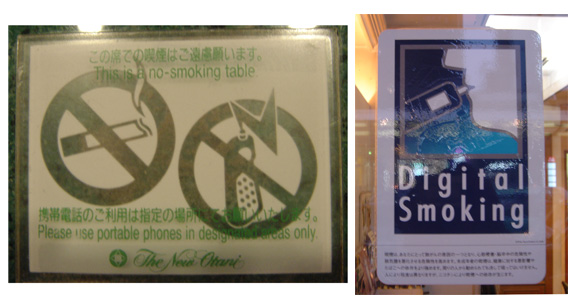IEEE Internet Computing, March/April
2007:
How I spent my summer vacation
Last summer, my wife and I found ourselves approaching a numerically significant wedding anniversary and began to talk about how best to celebrate the event. We felt like we had to do something a little out of the ordinary, and we both like to travel, so we settled on what has become known as “the trip”: we went around the world in 22 days. A short trip, to be sure, but it was all the vacation time we could muster. After spending several days with maps and airplane schedules, we settled on 10 destinations, with stops in Japan, Hong Kong, India, Greece, Egypt, and London. It was a great trip — we only occasionally felt as if we had bitten off more than we could chew.
This column isn’t meant to be an excuse to show people my vacation pictures, but I thought it could be interesting to pass along some observations about technology and the Internet that we collected during the trip. Readers local to some of the places I’ll be writing about may find what I have to say amazingly obvious or hopelessly naive. If so, I hope you’ll grant me the leeway given to a traveler who has spent too many hours on too many airplanes traveling through too many time zones, and feel free to gently correct me.
What should we take?
As my wife and I planned the trip, we quickly encountered the question of how connected we wanted to be while traveling. This was a vacation, so we had no need for serious work connectivity and applications. But it was easy to anticipate situations in which a Web browser or an email client might be useful, and, for better or worse, my wife (who is about as wired as I am) and I weren’t going to completely unplug ourselves for three weeks.
Still, we didn’t want to take a laptop with us — too much weight and bulk when we were trying to travel light, too many worries about where that expensive thing was and what might be happening to it. So we went much smaller and based our technology kit on a Palm T|X (www.palm.com/us/products/handhelds/tx/). It has a large screen for a handheld device — 3.8 inches diagonal, 480 x 320 pixels — and has built-in WiFi, which we expected to be generally available where we were traveling or, at worst, a good supplement to local Internet cafes and hotel business centers. The T|X also offers a competent Web browser and email client, and it supports applications useful for our travels, such as an electronic flight schedule. It also works with a small keyboard, which is good for composing blog posts and email. We loaded a memory card with scans of passports, tickets, maps, and other travel documents, packed a small bag full of batteries, adapters, and cables, and were ready to go. This collection, in combination with our GSM phones, met our needs quite well. Nevertheless, there were technical surprises and breakdowns along the way, and I’ll offer them to IC readers as illustrations of how Internet technologies are evolving in different parts of the world. (JRM note: that vertical bar between the T and X is really there in the product name.)
Internet availability and pricing
Despite the breadth of our trip, we were in few places where there wasn’t some sort of Internet connectivity nearby, or at most a short walk away. This sometimes felt very Western — I’m reminded of kids in the Cairo airport restaurant, joking and downloading semi-porn into their laptops and phones. Other times, it was quite different — weather-worn storefronts in the Indian countryside offering telephone service and Internet access, with water buffalos standing by the door.
Our connectivity was usually in hotels and airports, augmented by the occasional coffee shop or store. Our hotels offered a wide range of connection devices — mostly wired connections and Internet-over-powerline devices, and some with WiFi. On the whole, there was less WiFi in hotels than we expected; were we to do this again, we would probably take along a small wireless router. In any case, there were few times that we really wanted to get online and were unable to do so.
Something that surprised us was the almost complete lack of consistency in pricing. As a hotel owner, is access something you should charge for or something you should give away to attract business? The hotels in which we stayed varied in their rates; that is, anywhere from free (rare) to 5 euros per week to 30 euros per day. There were also unexpected corner cases: on a short cruise around some Greek islands, the ship’s Internet cafe offered connection at the rate of a couple of euros per 100 Kbytes of bandwidth. This seemed to us a scary and unpredictable way to price connectivity, but if you avoided graphically-rich Web pages and video sites, the cost was only a bit more than land-based connections. The bottom line is that business models for Internet access are still evolving, and there’s still much room for experimentation.
How do you manage your WiFi connection?
During the trip, we got to know pay-per-use WiFi services quite well. They’re all about the same: bring up a browser, get a login screen, enter your credit-card number or a PIN from a phone card, and you’re off. My favorite might have been in Greece, where we signed up for a plan that gave us three hours of access to the Greek phone company’s WiFi hotspots for 10 Euros. This access time was spread out over a full month, which was great: we needed access for several days, but only for short periods of time on each day.
There was, however, a downside to the service. Not surprisingly, it was designed around the assumption that we were using some sort of standard PC and browser that was able to show two windows at once: one for our browsing and one small one to show us how much time we had left on the card and to give us a button that would let us log out and save our remaining access time for later.
However, our Palm and its browser, while quite full-featured, doesn’t have the concept doesn’t support multiple browser windows — it offers one, and only one. So, as we browsed, we lost access to the window with the sign-out button. It was a challenge to navigate our way back through the browser cache to the small window that would let us log out. Our device’s design simply didn’t match the service’s needs.
Of course, at least we had a display and something of a keyboard — what if we were using a next-generation mobile WiFi-enabled device of the sort often written about in IC’s pages, which might have neither? How would we enter a new area, sign up for usage, and get our device connected? And who provides the networking service we’re relying on? Are there things that they have to do for my device or application to work properly? These aren’t insurmountable issues, to be sure — we could all make lists of ways around these problems and others like them that we could identify. But it served to remind me of how important it is to stay aware of the complete nature of a system and the technical, social, and economic environment it lives in. It’s important to know what parts of the system you can control, what parts others control, and what we must do to make them work together.
A different balance between Internet and phone
I would report that cell phones were everywhere, even in the less-developed parts of the countries we visited, but you knew that already. This isn’t the place to talk about Internet and cell-phone usage in those parts of the world — suffice to say the economics are very different there than in the West, and business and usage models have evolved in very different ways as well.
I’ll mention one thing that caught my eye in India, where cell-phone usage is especially strong. TV commercials in the West often conclude with the logo for the advertised company and the URL of the company’s Web site. In India, the TV commercials had much the same form, except that the URL was replaced by information about how to contact the company by an SMS text message — “send NEWCAR to 55938.” This observation held up across media: overall, we saw far fewer URLs and far more SMS invitations in India than in the other countries we visited, even those with significant cell-phone use, such as Japan.
Responding to one of these invitations kicks off a series of marketing messages to (and from) the customer. Some of these might include URLs in case the customer has a PC and wants to pursue that route, but I’m told that it’s quite common to carry on a marketing event purely with SMS. This is encouraged by the prevalence of phones in the society and the service plans that make text messages very inexpensive. The advertisers’ goals are much the same as in the US; it’s just that their strategies have evolved to fit the different technology landscape and usage models.
Some observations on design

We take our technology products seriously in the US, and their physical design reflects this: lots of rectangular packages, usually offered in black, silver, and beige. Not so in Japan and Hong Kong, where we found a much more playful attitude towards product design. We found the things shown in Figure 1 in Japan and Hong Kong — a mouse with not just a happy face, but with an illuminated plastic aquarium containing water, rocks, plastic flowers, and seashells. We picked up a couple of Web cams in the shape of cartoon characters, and Hello Kitty also made her inevitable appearance, here as a flash drive. More “traditional” versions of these devices were also available, of course, and they were just as boring as those in the US. I’ll leave the sociological rationalizing of these different tastes in design to others, but personally I think the fun is nice.
Another design story, but this one about myself. I found a very nice brushed aluminum case for my iPod Shuffle in Kyoto, for only US$7. It wraps around the iPod (Figure 2) and screws together firmly. It feels very solid and nice, and I really like it. But, after a few days of use, I realized it was a triumph of fashion over functionality.

So, from a functionality perspective, it’s really an awful case, and, as a card-carrying usability guy, I shouldn’t want to have anything to do with it. But, then, why do I like it so much — even now, after I’ve acknowledged all its shortcomings? And why am I buying a decorative case for an inexpensive piece of white plastic anyway? There’s much more to think about here.
Privacy and intrusion issues

In Japan, I also found sensitivity to the intrusive aspect of technology, especially with respect to cell-phone usage. The intrusive nature of talking on a cell phone is confronted head-on there: hotels post signs (albeit usually ignored) identifying the areas in which cell phones are permitted (Figure 3). Similarly, Tokyo subways note that riders shouldn’t use cell phones near the seats reserved for the elderly.
I had heard about these attitudes before the trip; what I was surprised to find was a growing metaphorical connection between cell-phone use and that other intrusive habit, smoking. For instance, our hotel included notices of cell-phone restrictions on the nonsmoking signs in the hotel lobby. But the most explicit version of this connection was a sign, seen in Kyoto, drawing a much more distinct connection: a cigarette morphing into a cell phone, labeled as “digital smoking” (Figure 3). Wow. Japan has had a lot of experience with cell-phone use, and it’ll be interesting to see if this parallel turns up elsewhere.

Home again
The trip was great fun. I think it’s a good thing to use travel as a way to get yourself outside your usual comfort zone and be able to see your usual surroundings from a somewhat different perspective. But this sort of experience is likely to become more than just fun — as the markets outside the US and Western Europe continue to grow in importance, having these kinds of experiences will become an essential part of product design. There’s always been a sense that tech people have to build products for people who aren’t like them, but these differences have generally been related to technical expertise and familiarity with the technologies at the heart of the problem — the old question of how to make a particular combination of technologies “user friendly.” What’s happening now is that these gaps are expanding in both size and nature — the issues aren’t simply matters of technical complexity, but a more complex notion of cultural fit. If you’re not thinking and worrying about such changes, you ought to be —they’re going to have a major effect on the technology world in the years to come.
